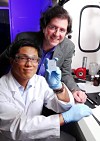 One of the big problems facing society in its search for sustainable alternative energy sources is not how to harness wind, solar, or wave power, but how to store the electricity produced using these elements at times of low demand. Capacitors could be the answer. These devices can be charged up very quickly, store electrical energy for long periods, and then be discharged rapidly for a range of applications. Such capacitors are on the horizon but their small-scale cousins are developing even more rapidly for portable applications. Find out more in the May issue of Intute Spotlight.
One of the big problems facing society in its search for sustainable alternative energy sources is not how to harness wind, solar, or wave power, but how to store the electricity produced using these elements at times of low demand. Capacitors could be the answer. These devices can be charged up very quickly, store electrical energy for long periods, and then be discharged rapidly for a range of applications. Such capacitors are on the horizon but their small-scale cousins are developing even more rapidly for portable applications. Find out more in the May issue of Intute Spotlight.
Also under the Spotlight this month, Norwegian scientists have drawn up a league table of alternative fuels for cars based on what they call a “well-to-wheel” analysis. Their approach takes into account the energy costs in manufacturing, total energy use, and overall pollution included greenhouse gas emissions. Unsurprisingly, petrol and diesel vehicles foot the table, closely followed by hybrid vehicles. In contrast, the greenest way to power a vehicle turns out to be to use an electric fuel cell powered by hydrogen made from natural gas, methane.
Finally, in the 1950s, the atomic clock was the pinnacle of split-second time-keeping. Today, physicists use its successors based on energy transitions in rubidium atoms that gives them 100 times more accuracy. These clocks currently operate at their theoretical limit but nevertheless are accurate to one second every 50 million years. Quantum noise, the random fluctuations of atoms and ions and the grim truth of Heisenberg’s Uncertainty Principle would probably mean no improvements for the next 50 million years.